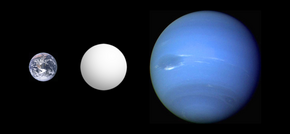
Back كوروت-7b Arabic COROT-Ekzo-7b Azerbaijani CoRoT-7b Bulgarian COROT-7b Czech CoRoT-7 b German CoRoT-7b Esperanto COROT-7b Spanish کوروت- ۷بی Persian CoRoT-7b Finnish CoRoT-7 b French
 Size comparison of CoRoT-7b (center) with Earth (left) and Neptune (right) | |
| Discovery | |
|---|---|
| Discovered by | Rouan et al. (CoRoT) |
| Discovery site | Polar orbit |
| Discovery date | February 3, 2009 |
| Transit | |
| Orbital characteristics | |
| 0.0172 ± 0.00029 AU (2.573 ± 0.043 million km; 1.599 ± 0.027 million mi)[1] | |
| Eccentricity | 0 |
| 0.853585 ± 0.000024 d (20.48604 ± 0.00058 h)[1] | |
| Inclination | 80.1 ± 0.3[1] |
| Star | CoRoT-7 |
| Physical characteristics | |
| 1.528±0.065 R🜨[2] | |
| Mass | 6.06±0.65ME[2] |
| Temperature | 1,300–1,800 K (1,030–1,530 °C; 1,880–2,780 °F)[3] |
CoRoT-7b (previously named CoRoT-Exo-7b)[3][4] is an exoplanet orbiting the star CoRoT-7 in the constellation of Monoceros, 489 light-years (150 parsecs) from Earth. It was first detected photometrically by the French-led CoRoT mission and reported in February 2009.[5] Until the announcement of Kepler-10b in January 2011, it was the smallest exoplanet to have its diameter measured, at 1.58 times that of the Earth (which would give it a volume 3.95 times Earth's) and the first potential extrasolar terrestrial planet to be found. The exoplanet has a very short orbital period, revolving around its host star in about 20 hours.[1]
Combination of the planet's diameter derived from transit data with the planet's mass derived from radial velocity measurements means that the density of CoRoT-7b is about the same as that of Earth; therefore, CoRoT-7b is a terrestrial planet like Earth and not a gas giant like Jupiter. The radial velocity observations of CoRoT-7 also detected a second super-Earth, CoRoT-7c, which has a mass 8.4 times that of Earth and orbits every 3.7 days at a distance of 6.9 million km (0.046 AU; 4.3 million mi).
- ^ a b c d Cite error: The named reference
leger2009was invoked but never defined (see the help page). - ^ a b Anna John, Ancy; Collier Cameron, Andrew; Wilson, Thomas G. (2022), "The impact of two non-transiting planets and stellar activity on mass determinations for the super-Earth CoRoT-7b", Monthly Notices of the Royal Astronomical Society, 515 (3): 3975–3995, arXiv:2206.14216, doi:10.1093/mnras/stac1814
- ^ a b Cite error: The named reference
esa_discoverywas invoked but never defined (see the help page). - ^ Schneider, J. (10 March 2009). "Change in CoRoT planets names". Exoplanets. (Mailing list). Archived from the original on 18 January 2010. Retrieved 19 March 2009.
- ^ Cite error: The named reference
symp09was invoked but never defined (see the help page).